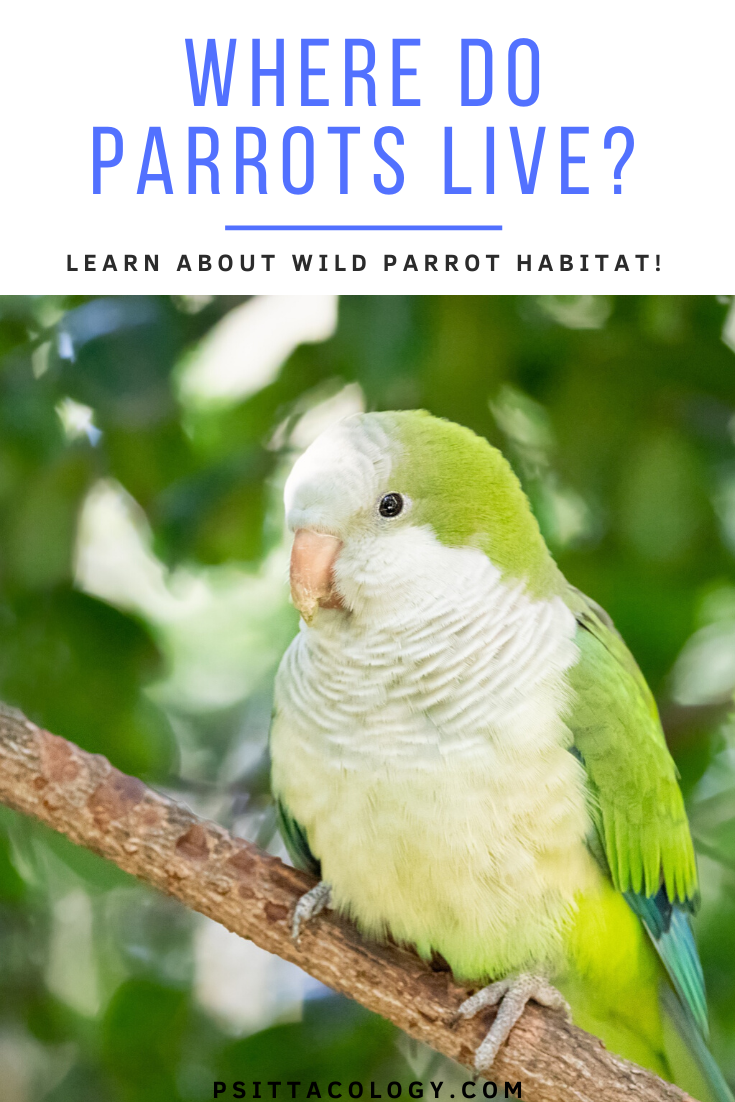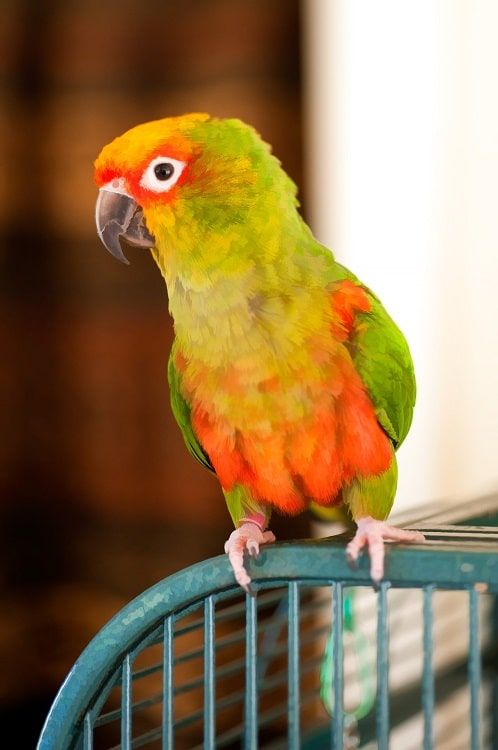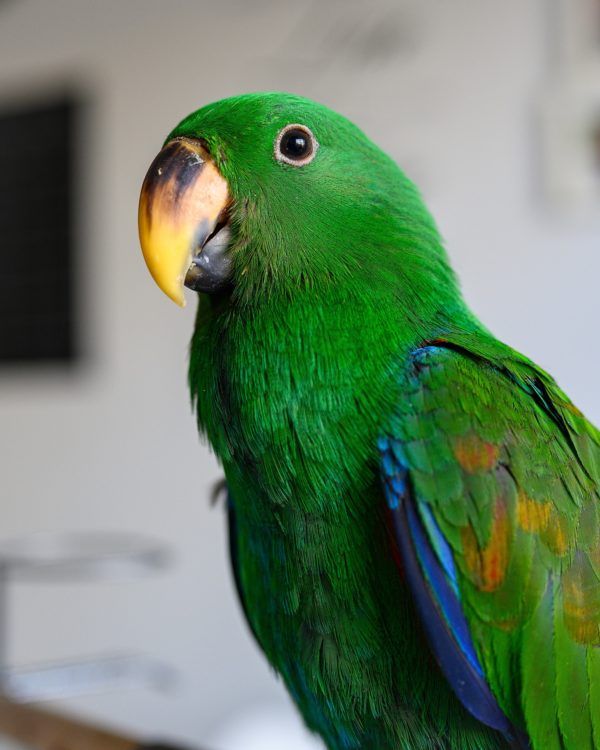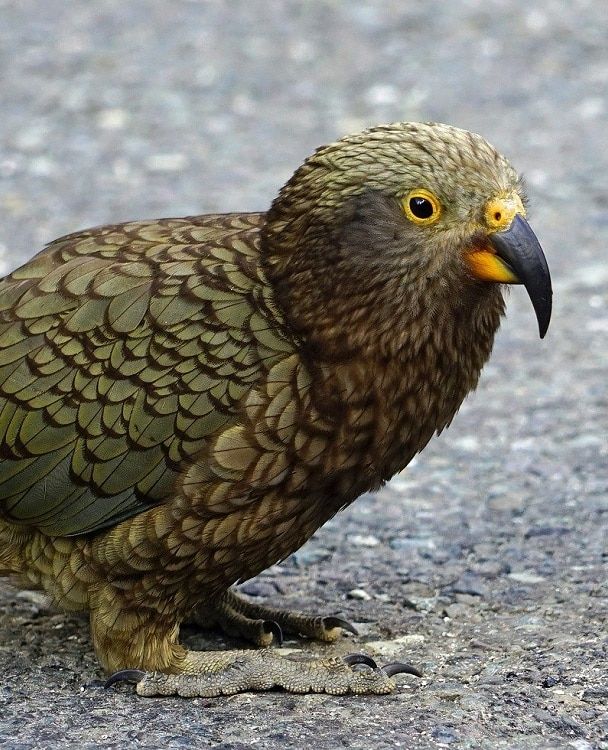If you keep one of the many parrot species out there as a pet, you might be interested in knowing more about where your feathered friend would have lived if it were a wild parrot. And that’s good: studying a pet’s habitat in the wild can tell us a lot about how we should care for it in our homes. So where do parrots live?
Let’s discuss where some of the popular pet parrots live and what their habitats look like!

Central & South American parrots
- Conures (genus Pyrrhura, Aratinga etc.): The various types of conures, like sun conures, green cheek conures, nandays, jendays, crimson bellies and more have a pretty wide range in South America. Brazil is especially rich in conure diversity, mostly in forests and woodland.
- Lineolated parakeets (Bolborhynchus lineola): These funny little parakeets are found in highland forests in Mexico, Panama, the Andes mountains, Venezuela and Colombia.
- Amazon parrots (genus Amazonas): The many species of Amazons are found all over South America as well as into Mexico and the Caribbean. Their habitats are pretty diverse, ranging from relatively open savanna lands to deep rainforests.
- Macaws (genus Ara, Anodorhynchus, etc.): Probably the most famous of parrots, the many gorgeous species of macaw are New World natives, meaning they’re found in South America. Their habitats also extend into Central America and Mexico. They mainly inhabit rainforests although some species can also be found in less forested areas.
- Caiques (genus Pionites): These medium sized parrots are naturally found around the Amazon Basin area, where they inhabit forests. Caiques mostly stick to the treetops.
- Parrotlets (genus Forpus, Nannopsittaca, etc.): These are the smallest South American parrots, even smaller than the already tiny lineolated parakeet. They inhabit Central America and Mexico and have a wide range in South America. Parrotlet habitat is very varied, although they generally prefer somewhat open areas and are not usually found in deep forests.
- Quaker parrots: Aside from the huge feral populations that have established worldwide (and are considered quite a nuisance!), quaker parrots are found in the southern end of South America in and around Argentina. Here, they build massive family nests in treetops.

Asian parrots
- Eclectus parrots (Eclectus roratus): This colorful species can be found in parts of Indonesia (Moluccas and Sumba islands), although it also occurs in the continent of Oceania. Eclectus parrots nest in hollow rainforest trees.
- Indian ringnecked parakeets (Psittacula krameri): Now, as with Eclectus parrots, Indian ringnecks are actually not restricted to Asia. There are two African subspecies, giving the genus as a whole an incredibly wide range. The two Asian subspecies, which are larger than their African counterparts, can be found in India and surrounding countries.
- Alexandrine parakeets (Psittacula eupatria): These are members of the same genus as the Indian ringneck parrots and very similar in appearance. They can be found in forests in India, as well as parts of South and South East Asia.
- Cockatoos (genus Cacatua, Zanda, etc.): Various cockatoo species are naturally found in Asia. There’s the popular Moluccan cockatoo which, as the name suggests, is naturally found in Indonesia and particularly the Moluccas islands. Other Asian cockatoos include the umbrella cockatoo, citron-crested cockatoo and the Goffin’s cockatoo.
- Hanging parrots (genus Loriculus): Also known as bat parrots, these funky guys sleep upside down. Naturally found in various habitats in Southern Asia, they’re not really common pets.

African parrots
- Lovebirds (genus Agapornis): Probably the most well-known parrots from the African continent are lovebirds. They can be found in various habitat types from forests to savanna as well as urban environments: feral populations exist in many parts of the world.
- Senegal parrots (genus Poicephalus): These black-headed birds naturally occur in West Africa, where they inhabit open areas such as savannaland.
- African grey parrots (genus Psittacus): This popular pet parrot is naturally found in equatorial Africa; it’s also sometimes referred to as the Congo parrot because it can be found in this country. In their natural habitat, African greys prefer dense forest.
- African ringnecked parrots (Psittacula krameri): The distribution of the Indian ringneck’s African cousins (which belong to the same species) pretty much cuts right through Africa in a straight line, from Guinea in the west to Somalia in the east. It’s also found in Egypt. They can usually be found perched in palm- and other trees, far from the dangers on the ground.

Australian parrots (& New Zealand)
Australia
- Budgies (Melopsittacus undulatus): The most popular parrot in the world, the budgerigar, is naturally found in the harsh inland habitats of Australia. Here, they don’t stay in one place much: flocks are nomadic and move around in an attempt to find spots with plenty of food and water. Open habitats like grasslands are preferred.
- Cockatiels (Nymphicus hollandicus): Australia also has the honor of being home to the second most popular parrot. Cockatiels are a small cockatoo variety that can be found in bushland and wetland throughout almost the entire country. These areas are very dry, so like budgie flocks, cockatiels move around in order to always be close to water sources.
- Cockatoos (genus Cacatua, etc.): Many cockatoo species can naturally be found in Australia, including some of the most popular species. Galah cockatoos inhabit open habitats throughout the country, while sulfur-crested ‘toos prefer woodland.
The colorful Major Mitchell’s cockatoo inhabits the arid inlands. Some species, like the bare-eyed cockatoo and the black palm cockatoo (the largest cockatoo), can be found both Australia and New Guinea. The latter only occurs in the northernmost tip of Queensland.
- Lorikeets & lories (genus Trichoglossus, Lorius etc.): These colorful birds are common throughout Australasia including Australia, Polynesia, South East Asia and Papua New Guinea. The rainbow lorikeet, which is most commonly kept as a pet, is an Australian native that inhabits areas rich in plant life, including backyards. Lories and lorikeets need these trees and bushes to find their main food source: nectar.
- Rosellas (genus Platycercus): These colorful parrots are typically Australian and can also be found in Tasmania. They inhabit coastal regions and are not too picky when it comes to habitat type.
- Bourke’s parakeets (Neopsephotus bourkii): The gentle, colorful Bourke’s parakeet occurs in large parts of Australia, where it inhabits forested areas featuring Acacia, eucalyptus and cypress. It does move around just like budgies and cockatiels do, always in search of food and water sources.

New Zealand
New Zealand is known for hiding no shortage of strange birds in its extensive nature: it’s the home of the kiwi, after all! It also features some very unusual parrots.
- Kea (Nestor notabilis): This large species is an alpine parrot, preferring mountainous regions on the South Island. Unlike many other parrots it is an omnivore that also feeds on carrion.
- Kakapo (kākāpō, Strigops habroptilus): You’ve probably heard of this one, even if it’s just because of this hilarious video. This large, ground-dwelling parrot species once had a wide range across New Zealand but is now critically endangered due to the introduction of predators like cats.
- Kakariki (kākāriki, genus Cyanoramphus): Also known as New Zealand parakeets, these are relatively popular as pets. The three species are found on both the mainland and outlying islands.
- Kaka (kākā, Nestor meridionalis): This large parrot is similar to the kea, although its preference lies in lowland forest rather than alpine areas. Its natural distribution was shrinking quickly but conservation efforts do appear to be effective so far.
Honorable mention: New Guinea, also part of Australasia, is home to an extraordinary range of parrots for such a small area. Lories, lorikeets, fig parrots and a whole bunch of other species are naturally found there. Honorable mention goes to the Dracula parrot, a fig-eating species that has received attention in popular media for its scary looks.

North American and European parrots?
Are there parrots in North America and Europe? There are, loads of them actually. However, they’re not native to the continents: they were introduced by humans.
- London and other cities are home to massive populations of Indian ringneck parrots.
- Quaker parrots are actually banned in Spain and some US states because they’re so invasive.
- Lovebirds can be spotted in France and Southern US states (among other places).
So are there any native North American parrots? Sadly, not anymore. The beautiful Carolina parakeet was once common but declared extinct in 1939, while the thick-billed parrot which was previously found in Southwestern US states now only resides in Mexico. As fossils show, other species also inhabited the area that now comprises the United States.
How about Europe? No endemic species here, although fossils have been found.

So where do parrots live in the wild? All over, really! If you have any more questions about where wild parrots live or if you want to share your own knowledge on natural parrot habitat, don’t hesitate to leave a comment below!
Still want to know more? There is a full list of all parrots and their natural ranges on Wikipedia, but beware, it’s long.
